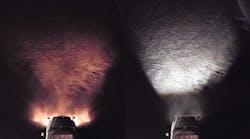As costs have continued to decrease and the state of the technology has fast advanced for light-emitting diodes, or LEDs, additional uses and benefits of LED lights have been emerging. LEDs can increase truck and other vehicle safety/ road visibility; conserve energy and reduce power drain; can do things like simulate sunlight or sunset in a truck cab to improve driver health, wellness, sleep, and alertness; can offer better interior light engineering possibilities; and can even disinfect the inside of a reefer trailer.
Not surprisingly, the application of LEDs is becoming increasingly common in all types of vehicle lighting systems. Along with headlamps and stop/tail/turn assemblies is a growing range of auxiliary lighting solutions featuring LEDs. Across all of
these applications, LEDs offer longer service life expectancy compared to conventional bulbs, brighter light that comes on faster, and lower energy consumption needs than standard bulbs.
The Peterson line of LumenX LEDs, which covers a range of applications, now includes the manufacturer’s 290 series LED license/Utility light. Designed with a single-diode Great White LED, the 290 series lights are low-profile utility/ auxiliary lamps measuring 3 in. wide by 0.6 in. high or license plate lights when installed with either a top- or side-mount spacer bracket. Hard-wired with a choice of either stripped leads or 0.180 bullet connectors, the new lights surface-mount on 2-in. centers.
The Rigid Line of LED fog lights for Class 8 trucks from Truck-Lite are available for 2007-2016 Freightliner Cascadia, 2017-2018 International Prostar, 2008-2017 Volvo VN and 2013-2018 Kenworth T680 models. A universal mounting kit is also available. The SAE J583-compliant lights feature waterproof H11 Deutsch adapter plugs that connect directly into the factory-installed wiring harness. They have a low profile, solid-state design that includes a die-cast housing and polycarbonate lens. The lamps also have over/under voltage and reverse polarity protection.
For auxiliary applications, Grote now offers permanent, vacuum and magnetically mounted beacon lights in regular and high profiles, colors including amber, white and blue, and a variety of pulsating strobe effects. The lights come in several SAE classes. LED directional surface-mount strobes in 3-, 6- and 12-diode options feature 12 different selectable flash patterns, including steady-on. Versions with 20-, 30- and 40-in. LED “traffic directors” with 34 warning flash patterns and five-phase options are also available.
The new ILL38CMB Corner-Mount interior lamp from Optronics relocates interior lighting to the corners of a vehicle’s ceiling, away from the high-traffic central core where it is vulnerable to damage. The corner location also provides opposing beam directions that reduce shadows and dark areas. The ILL38CMB has a modular design that enables multiple lamps to be spaced within a vehicle or configured as two continuous bars of light on both sides throughout the entire length of a vehicle. The corner-mount design attaches to both the ceiling and the wall. The lamp operates in both refrigerated and non-climate-controlled environments.
The Optronics UCL41 series directional scene light features 12 diodes and advanced optics. With a focused beam pattern, the company notes that OEMs, bodybuilders, and end users can dictate the size, shape and brightness of the scene environment they desire. The low-profile surface-mount lamp measures 8.7 in. wide and 2.95 in. high, and including its mounting plate and bezel is 1.59 in. thick.
Optronics is also working with vehicle OEMs on new ergonomic lighting environments for cabs and sleepers. The concept is built around “adaptive lighting controls,” which the company said will help boost productivity during work-hours, restfulness during HOS rest periods, and overall environmental health in a sleeper cab.
The lighting scenarios being explored would allow drivers to self-select a lighting combination they find comfortable but would also enable them to select preprogrammed lighting environments based on their activities. For instance, an “awakening phase” would be red-shifted like a sunrise and might increase in intensity over time. An “alert phase” would be blue-shifted like the mid-day sun. A “resting phase” would be red-shifted but would lessen in intensity over time, like a sunset. A “sleeping phase” would minimize all ambient light and might also be motion activated with automatically dimming convenience lighting.
There would also be a hygiene setting that would cleanse cab and sleeper, dry vans, and reefers of contaminants like bacteria, mold and fine particulate matter using only light. Applications for the new cleansing lamps could include food- and cold-chain vehicles because of the need to maintain hygienic conditions at all times.
The rising quality and lower prices of the technology continue to make LED lights more attractive for fleets. In many cases previously, the cost to upgrade to LED lights was prohibitive. Today, manufacturers believe that many LED models will soon become less expensive as producers phase out other lighting technologies in favor of LED solutions.






